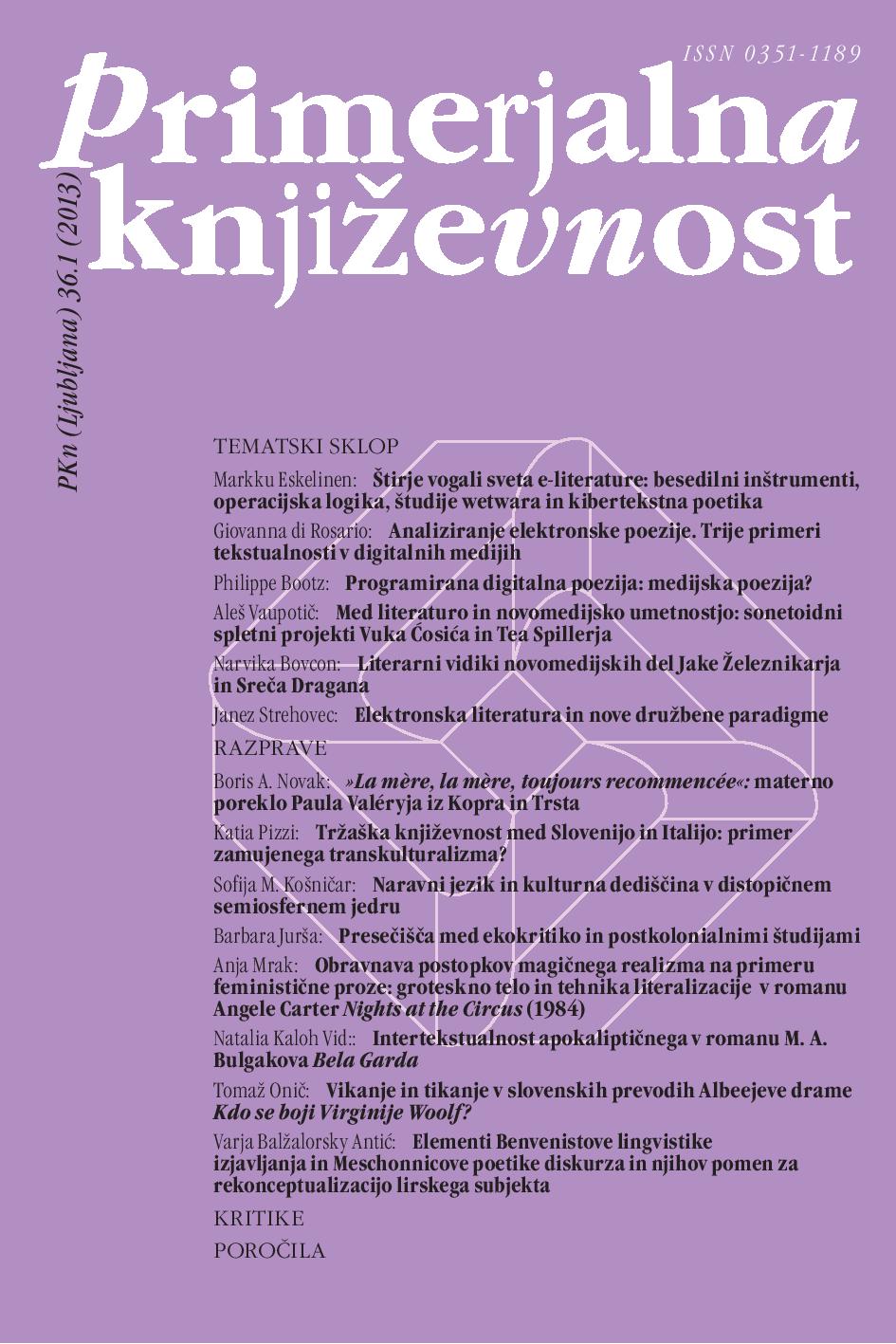Do the Domains of Literature and New Media Art Intersect? The Cases of Sonnetoid Web Projects by Vuk Ćosić and Teo Spiller
Keywords:
new media, digital poetry, sonnet, cybertext, literariness, Ćosić, Vuk, Spiller, TeoAbstract
Franco Moretti’s notion of “distant reading” as a complementary concept to “close reading”, which has emerged alongside computer-based analysis and manipulation of texts, finds its mirror image in a sort of “distant” production of literary works – of a specific kind, of course. The paper considers the field in which literature and new media creativity intersect. Is there such a thing as literariness in “new media objects” (Manovich)? Next, by focusing on the websites that generate texts resembling and referring to sonnet form, the article asks a question about the new media sonnet and a more general question about new media poetry. A mere negative answer to the two questions seemingly implied by Vuk Ćosić’s projects does not suffice because it only postpones the unavoidable answer to the questions posed by existing new media artworks and other communication systems. Teo Spiller’s Spam.sonnets can be viewed as an innovative solution to finding a viable balance between the author’s control over the text and the text’s openness to the reader-user’s intervention. In conclusion, two concrete reconfigurations of the experience of (new media) literature – and through it the surrounding world – are considered: the experience of time in Spiller’s News Sonnets and the spatial dimension as implied in his project SMS Sonnets. News Sonnets uses current news obtained via RSS feeds from various sources, which makes the “messages” contained in the lines of the sonnet a potential stimulus for readers’ immediate action. SMS Sonnets expands the territory where the communication takes place beyond the text-reader confrontation and into the community of participants in an interactive (non-artistic) communication system.References
Aarseth, Espen J. Cybertext: Perspectives on Ergodic Literature. The Johns Hopkins University Press, 1997.
Aesthetics and Politics: Ernst Bloch, Georg Lukács, Bertolt Brecht, Walter Benjamin, Theodor Adorno. London: NLB/Verso, 11977.
Allison, Sarah & Ryan Heuser & Matthew Jockers & Franco Moretti & Michael Witmore. »Quantitative Formalism: An Experiment.« Pamphlet 1. Pamphlets – Stanford Literary Lab. Jan. 2011. Splet 12. jun. 2011. http://litlab.stanford.edu/LiteraryLabPamphlet1.pdf.
Arac, Jonathan. Impure Worlds: The Institution of Literature in the Age of the Novel. New York: Fordham University Press, 2011.
Benjamin, Walter. The Origin of German Tragic Drama. London, Brooklyn, NY: Verso, 2009.
Bovcon, Narvika. Umetnost v svetu pametnih strojev. Ljubljana: Institut Akademije za likovno umetnost in oblikovanje, UL, 2009. Splet 26. feb. 2013. http://usps.bovcon.com/bovcon_usps.pdf.
(The) Commens Dictionary of Peirce’s Terms. Ur. Mats Bergman in Sami Paavola. 2003. Splet 4. apr. 2010. http://www.helsinki.fi/science/commens/dictionary.html.
Cramer, Florian. »sub merge {my $enses; ASCII Art, Rekursion, Lyrik in Programmiersprachen.« Splet 13. jun. 2011. http://cramer.pleintekst.nl:70/all/ascii_art_rekursion_programmiersprachen-lyrik/ascii_art_rekursion_programmiersprachenlyrik.pdf.
Daiber, Jürgen. »Der elektrisierte Physiker | Wissen | ZEIT ONLINE.« Splet 15. feb. 2010. http://www.zeit.de/1998/37/199837.t_ritter_.xml.
Enzensberger, Hans Magnus. Einladung zu einem Poesie-Automaten. Frankfurt ob Majni: Suhrkamp, 2000. Splet 25. jun. 2011. http://jacketmagazine.com/17/enz-robot.html.
Flusser, Vilém. Digitalni videz. Ljubljana: Študentska založba, 2002.
– – –. Kommunikologie. Frankfurt ob Majni: Fischer,11996, 42007.
– – –. Kommunikologie weiter denken: Die Bochumer Vorlesungen. Frankfurt ob Majni: Fischer, 2009.
Im Buchstabenfeld: Die Zukunft der Literatur. Ur. Peter Weibel. Gradec: Literaturverlag Droschl, 2001.
Ingarden, Roman. Literarna umetnina. Ljubljana: ŠKUC FF, 1990.
Juvan, Marko. Literarna veda v rekonstrukciji. Ljubljana: LUD Literatura, 2006. Splet 25. jun. 2011. http://reelc.net/?q=bib/literarna-veda-v-rekonstrukciji-uvod-v-sodobni-studij-literature.
Kos, Janko. Literatura. Ljubljana: DZS, 1978.
Manovich, Lev. The Language of New Media. Cambridge, Mass: MIT Press, 2001.
Mitchell, William J. Thomas. What Do Pictures Want? Chicago, London: University of Chicago Press, 2005.
Moretti, Franco. »Conjectures on World Literature.« New Left Review 1 (2000). Splet 15. jun. 2011. http://www.newleftreview.org/A2094.
– – –. »Network Theory, Plot Analysis.« Pamphlet 2. Pamphlets – Stanford Literary Lab. 1 May 2011. Splet 18. jun. 2011. http://litlab.stanford.edu/?page_id=255.
Quaranta, Domenico. Media, New Media, Postmedia. Milano: Postmedia Books, 2010.
Sonet. Ur. Boris A Novak. Ljubljana: DZS, 2004.
Spiller, Teo. Besedilnost novih medijev. Ljubljana: Dober, zavod za sodobno umetnost, 2011.
– – –. Znakovnost novih medijev. Ljubljana: Dober, zavod za sodobno umetnost, 2011.
Strehovec, Janez. Besedilo in novi mediji. Ljubljana: LUD Literatura, 2007.
Vaupotič, Aleš. »Kdo izbere, kaj bralec bere? Kibertekstualna perspektiva.« Primerjalna književnost 33.2 (2010): 151–161.
– – –. »Literarno-estetski doživljaj in novi mediji – prihodnost literature?« Primerjalna književnost 30.1 (2007): 203–16.
Weibel, Peter. »Einleitung.« Im Buchstabenfeld. 11–65.


